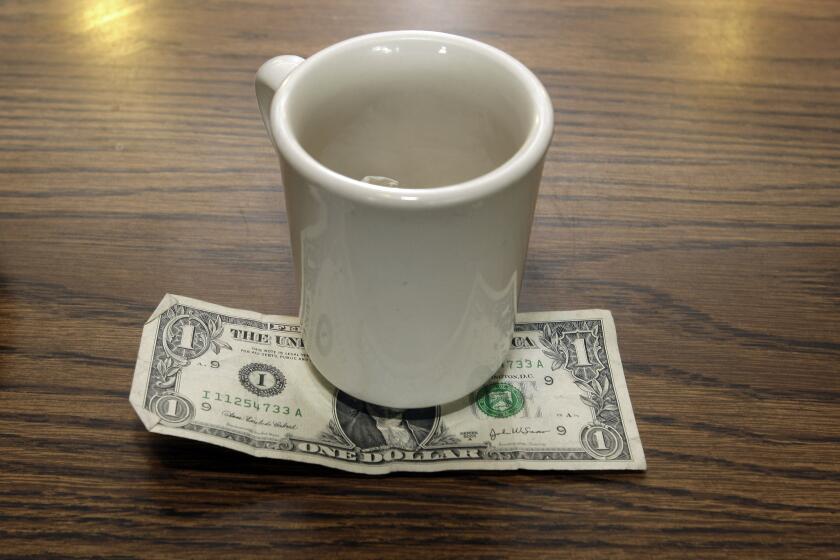No Smoke, No Oak: Just Fume
- Share via
Going just by the numbers, Chardonnay is a success. Sales are brisk, especially in restaurants, both by the bottle and by the glass. By the same measure, Sauvignon Blanc is a disaster. Sales haven’t risen in years.
Yet if you rated the two wines based on whether the average consumer, someone with little or no knowledge of wine, could count on getting a good bottle, the story would be the reverse.
I have blind-tasted about 400 Chardonnays this year and have found only 20% I could recommend--and far fewer I’d personally drink. Yet of some 250 Sauvignon Blancs I’ve sampled, at least half were worth recommending, and I’d be happy to sip any of more than 100.
Meanwhile, the average price for a bottle of good Chardonnay is somewhere between $12 and $18; yet most excellent Sauvignon Blancs are priced at $10 or less and are frequently deeply discounted.
So you may wonder why Sauvignon Blanc isn’t yet the household word that Chardonnay has become. I have a number of theories, chief among them the simple facts that 1) Chardonnay is easier to pronounce than Sauvignon Blanc, and 2) Chardonnay is a less complex wine, so it’s easier for beginners to understand.
*
Sauvignon Blanc has one additional failing: two different names (Fume Blanc is the other--in an oft-told bit of wine history, it is a name invented by Robert Mondavi as a marketing ploy) and a multitude of styles. As the names do not distinguish two different styles of wine, consumers have no way of knowing what they’re getting.
Among the popular styles of Sauvignon Blanc are wines that focus on melon and pear flavors (often with a trace of mint), on grassy-herbal flavors, on citrus flavors, and on an oaky style with a smoked element as a central theme. In each style, a winemaker may choose to either make the wine totally dry or leave a noticeable amount of sugar.
Though these wines are not comparable to one another, they are equally enjoyable when matched with the proper foods. But since few wine labels state precisely just what kind of wine the consumer is likely to find under the cork, confusion is the result.
“Sauvignon Blanc sales are pretty flat,” says Jon A. Fredrikson, president of the San Francisco wine consulting firm Gomberg, Fredrikson & Associates.
“Based on supermarket scanner trends, sales (of Sauvignon Blanc) were down a (percentage) point last year and up a point this year,” he says. “It’s clear that Sauvignon Blanc continues to be hurt by the genericization of Chardonnay--people calling for any Chardonnay. And that’s too bad, because Sauvignon Blanc is a varietal that goes well with many foods.”
Furthermore, talk to California winemakers and you’ll find they favor Sauvignon Blanc over Chardonnay by a wide margin. “I make Chardonnay for other people,” confided one Napa Valley winemaker. “I make Sauvignon Blanc for me.”
*
Fredrikson says the current status of Sauvignon Blanc is bleak for the industry, though it is a buyer’s paradise. There is a vast oversupply of the wine in the bulk wine market, and prices for it are down. As are prices for the grapes.
“I’m concerned because no one is replanting (Sauvignon Blanc),” says Michaela Rodeno, chief executive at St. Supery Winery in the Napa Valley.
In a survey released this month, Wines and Vines Magazine said only 269 U.S. wineries said they made Sauvignon Blanc last year, compared with 579 making Chardonnay. And the proportion of Sauvignon produced is even smaller than those figures suggest. Since 1983, Chardonnay plantings in California have more than doubled from 28,000 acres to 60,000 acres; in that same period, Sauvignon Blanc acreage increased only about 30%--from 10,400 acres to 13,500 acres.
Even the trade organization that is dedicated to improving the image of Sauvignon Blanc, the Society of Blancs (SOBs), is in disarray. Formed in 1990 at the urging of Dave Stare, owner of Dry Creek Vineyards, the SOBs are “rebuilding and regrouping,” according to executive director Lynn Garvey. She said the organization recently added five new members, bringing membership to 18.
Previously open just to the trade, anyone can now be an SOB. This week the group announced that for a $25 membership fee, new members would receive the society’s cookbook, a tasting kit featuring a flavor spectrum wheel, instructions for hosting a Sauvignon Blanc party, a T-shirt and discounts at member wineries. For details call Lynn Garvey at (707) 944-8031 or write to SOBs, 1925 Vintner Court, Yountville, Calif. 94599.
SOBs president Carolyn Wente, of Wente Bros. Winery, does speaking engagements about Sauvignon Blanc’s great affinity for food. But the group’s only major event this year was a public Sauvignon Blanc tasting in San Francisco . . . at which no food was served.
More to Read
Eat your way across L.A.
Get our weekly Tasting Notes newsletter for reviews, news and more.
You may occasionally receive promotional content from the Los Angeles Times.










